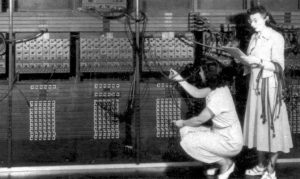The Accomplishment of the ENIAC and the Women Computing Pioneers

Marlyn Wescoff (standing) and Ruth Lichterman wire the right side of the ENIAC with a new program.U.S. Army Photo from the archives of the ARL Technical Library.
How to register:
We offer two field trip scheduling options:
- Select a field trip from the Museum’s public event schedule
- Request to schedule a field trip time that meets your group’s schedule
Audience:
All audiences. Content appropriate for Grades 4-12.
Goal:
Learn how the Army’s female computer programmers contributed to developing the field of computer science while expanding women’s roles on the World War II home front.
Program Description:
Discover how a talented group of female mathematicians laid the groundwork for the field of computer programming.
Winning World War II required an all-out effort. Thousands of women on the home front answered their country’s call to join the military, industry, and the civil service. In 1943, the U.S. Army recruited seven women mathematicians to set up and operate the Army’s newest top secret weapon: the Electronic Numerical Integrator and Computer (ENIAC). These unsung heroes wired the electrical connections that enabled the world’s first electronic, digital computer to complete 300 calculations per second. In doing so, they built a framework for the field of computer programming.
A Museum educator will guide the field trip as students discover how female “computers” solved complex problems, contributing to Army innovations during World War II.
Objectives:
At the end of the lesson, participants will be better able to:
- Describe how computers use electrical circuits to process data.
- Explain how needs identified during World War II led to the Army innovation that accelerated computer development.
- Discuss how World War II furthered women’s professional opportunities
Guiding Question:
How did ENIAC’s development and deployment affect the future of computing?
Curriculum Connections:
Common Core Standards
English Language Arts Standards » Science & Technical Subjects » Grade 6-8
Key Ideas and Details:
CCSS.ELA-Literacy.RST.6-8.3
Follow precisely a multistep procedure when carrying out experiments, taking measurements, or performing technical tasks.
Integration of Knowledge and Ideas:
CCSS.ELA-Literacy.RST.6-8.9
Compare and contrast the information gained from experiments, simulations, video, or multimedia sources with that gained from reading a text on the same topic.
History and Social Science Standards of Learning for Virginia Public Schools
-
United States History 1865 to Present
-
USII.6 The student will apply history and social science skills to understand the major causes and events of World War II and the effects of America’s role by
- G) evaluating the effects of the war on the home front, including, but not limited to women in the workforce, the incarceration of Japanese Americans, rationing, conservation, and war bonds.
-
USII.6 The student will apply history and social science skills to understand the major causes and events of World War II and the effects of America’s role by
-
Virginia and United States History
-
VUS.14 The student will apply history and social science skills to analyze the United States’ involvement in World War II by
- D) evaluating and explaining the contributions of heroic military units including, but not limited to segregated, minority units, women, and the role of Virginia units in the American war effort.
-
VUS.14 The student will apply history and social science skills to analyze the United States’ involvement in World War II by
Your message has been submitted.
